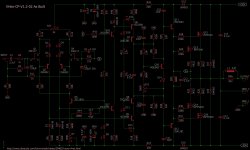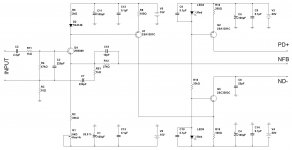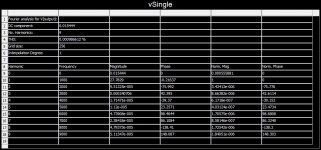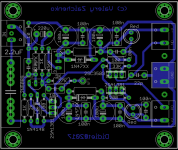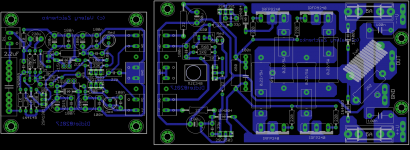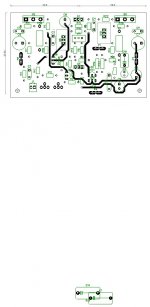Dan, what version do you use? Import/export is incompatible between the different versions. In any case, I can give you the SPICE models - you will create the user components yourself then (that's what I have actually done).
I'm using NI Multisim 14 (Power Pro Edition) but I can handle Spice models to define new components.
Thank you in advance,
Dan.
Thank you in advance,
Dan.
vSingle - a simple high-quality front-end
Hello All,
A very simple front-end desidn, based on the same principle, as the first VHex front-end. The critical, most non-linear piece is a single-transistor transconductance stage at the input (Q4). All the rest is driven by the current - highly linear current conversions.
Open loop 1KHz THD is less than 0.05%, with 40db NFB it comes down to 0.0005%, showing around 0.001% in combination with VHex+ OPS (2-nd picture is showing the Fourier analysis at 50W @ 8 ohm, +/-50V rails). 2-nd and 3-rd harmonics are dominant, all the rest are significantly lower.
Simple light compensation, good stability margins.
The VAS output stage can be easily adapted to any swing (OPS rails) - just adjust the value of R16 for having around 3mA through it.
PSRR is lower than the one, shown by the balanced designs, so I recommend to use regulated +/-15V supply (or at least having the good cap multipliers).
The layout is going to be rather simple - a good exercise for somebody who'd like to try 😉
Cheers,
Valery
Hello All,
A very simple front-end desidn, based on the same principle, as the first VHex front-end. The critical, most non-linear piece is a single-transistor transconductance stage at the input (Q4). All the rest is driven by the current - highly linear current conversions.
Open loop 1KHz THD is less than 0.05%, with 40db NFB it comes down to 0.0005%, showing around 0.001% in combination with VHex+ OPS (2-nd picture is showing the Fourier analysis at 50W @ 8 ohm, +/-50V rails). 2-nd and 3-rd harmonics are dominant, all the rest are significantly lower.
Simple light compensation, good stability margins.
The VAS output stage can be easily adapted to any swing (OPS rails) - just adjust the value of R16 for having around 3mA through it.
PSRR is lower than the one, shown by the balanced designs, so I recommend to use regulated +/-15V supply (or at least having the good cap multipliers).
The layout is going to be rather simple - a good exercise for somebody who'd like to try 😉
Cheers,
Valery
Attachments
A single side pcb will be usefulHello All,
A very simple front-end desidn, based on the same principle, as the first VHex front-end. The critical, most non-linear piece is a single-transistor transconductance stage at the input (Q4). All the rest is driven by the current - highly linear current conversions.
Open loop 1KHz THD is less than 0.05%, with 40db NFB it comes down to 0.0005%, showing around 0.001% in combination with VHex+ OPS (2-nd picture is showing the Fourier analysis at 50W @ 8 ohm, +/-50V rails). 2-nd and 3-rd harmonics are dominant, all the rest are significantly lower.
Simple light compensation, good stability margins.
The VAS output stage can be easily adapted to any swing (OPS rails) - just adjust the value of R16 for having around 3mA through it.
PSRR is lower than the one, shown by the balanced designs, so I recommend to use regulated +/-15V supply (or at least having the good cap multipliers).
The layout is going to be rather simple - a good exercise for somebody who'd like to try 😉
Cheers,
Valery
...... 😀
That was quick! 😀
Thanks a lot Didiet!
BTW - can you please make an option with a separate 2-pin plug for +/-15V supply - for those who would like to use a separate regulated supply for the input stage. It may fit somewhere in the middle, close to NFB pin.
My plan add 2-pin near zener, or just use zener pad as option for +/-15v supply.i will look again tomorrow, maybe another idea come up. Did you share vhex+ ops schematic?
Didied,
here is the thread with single ops VHex single sided by Abetir.
http://www.diyaudio.com/forums/soli...-amplifier-simulated-tina-23.html#post4685887
here is the thread with single ops VHex single sided by Abetir.
http://www.diyaudio.com/forums/soli...-amplifier-simulated-tina-23.html#post4685887
Bangla, I know the thread, i build one myself.
Didiet, great job - 100% single-sided, very DIY-friendly.
Thanks for sharing!
Cheers,
Valery
Yes didied fully clearly. 😛i build one myself
And also viewed to lykked Aleph minimize the J.
I am on learning use Diptrace- and have done this now.
Next i try a layout variant from VHEX+CP, but have to learn more.
- Home
- Amplifiers
- Solid State
- Sons of VHex
